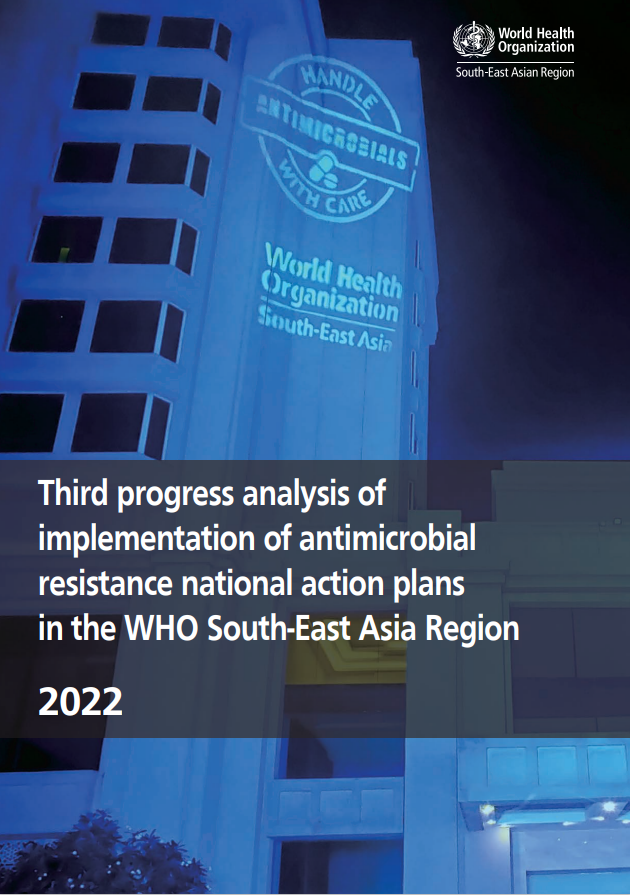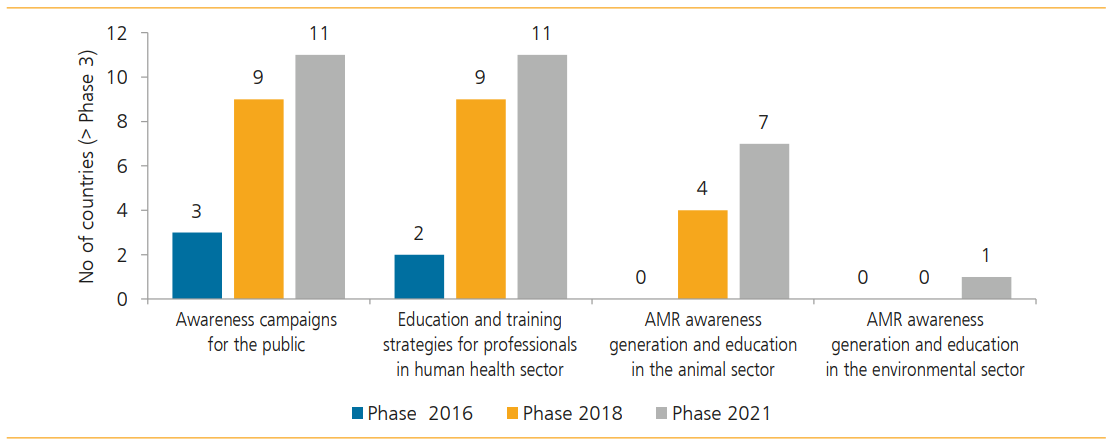Since 2019, Fleming Fund grantee, International Vaccine Institute (IVI), has led the CAPTURA consortium to expand the volume of historical data for antimicrobial resistance (AMR), consumption (AMC), and use (AMU) across 12 countries in South and Southeast Asia.
11 countries in South-East Asia are making progress against their AMR National Action Plans, new WHO report shows
Supported by a range of key stakeholders (including the Fleming Fund), the World Health Organization (WHO) recently published the Third Progress Analysis of the Implementation of Antimicrobial Resistance National Action Plans (NAP-AMRs) in South-East Asia.
The analysis shows that progress against the NAP-AMR was made in all eleven WHO Member States in the region during the period from 2018 to 2021, with Bhutan, Indonesia and Thailand making the greatest advancements. This is despite the COVID-19 pandemic and its associated challenges.

The cover of the Third Progress Analysis of Implementation of AMR-NAPs in the WHO South-East Asia Region.
The document outlines the Member States’ participation and results from a series of surveys to measure progress against their NAP-AMR. The survey results were analysed to inform several recommendations for policy makers in each country in the region.
Eleven out of the eleven Member States in the WHO South-East Asia Region are implementing a National Action Plan on AMR. Each NAP has been developed with the support of WHO, ensuring alignment to the global action plan to address AMR.
The analysis is structured in the following focus areas:
- National AMR plan and governance.
- Raising awareness of AMR.
- National AMR surveillance system.
- Rational use of antimicrobials and surveillance of use/sale.
- Infection prevention and control.
- Research and innovation.
- One Health engagement.
- Overarching coordination mechanisms for One Health engagement.
Results
Progress in the implementation of NAP-AMR for all countries in the region was 64% - much better compared to the 2nd Situational Analysis in 2018 of only 40% and the First Situational Analysis in 2016 of 16%. Countries did not report backward slides in the implementation status during 2021 compared to the situational analysis in 2018.
The Third Progress Analysis published in 2022 also observed progress in all eight focus areas. This demonstrates that despite the COVID-19 pandemic, prevention and control of AMR has remained a public health priority.
It is vital to engage the public to help address the ‘silent pandemic’, estimated by the Institute for Health Metrics and Evaluation (IHME) to be responsible for the deaths of 254,000 people in Southeast Asia, East Asia and Oceania in 2019.
Challenges and recommendations
While significant progress has been made, there continue to be many challenges, especially:
- One Health coordination and implementation, including surveillance across sectors.
- Enforcement of regulations for the prevention and control of AMR across sectors.
While many countries have significantly strengthened human health surveillance since 2018, this was not yet reflected in the animal health sector. Notwithstanding tangible progress made, animal health surveillance systems all scored lower than the human health equivalent. This is often due to a lack of resources, with the systems being at an earlier stage of development or implementation.
Little progress was reported in AMR awareness and education in the environmental sector. This underscores the importance of multi-sectoral coordination, communication, and collaboration to contain AMR. Advocacy and educational campaigns in the environmental sector need to be intensified, and practical guidelines, more technical support for early warning signs of AMR, and enforcement of environmental regulations are required.

A graph showing progress from 2016 to 2021 in education and AMR awareness raising.
Regulations to prevent and control AMR are often challenged by limited capacity for development and especially enforcement. In Thailand for example, there is a culture of prioritizing easy access to antibiotics to treat infection, combined with improved enforcement.
Dr Poonam Khetrapal Singh, Regional Director of WHO’s South-East Asia region, writes in her foreword:
Our efforts continue towards promoting rational use of antimicrobials among providers, consumers and communities, as well as towards strengthening surveillance systems for antimicrobial consumption and use. It is vital to coordinate the effective enforcement of regulating antimicrobial products from the production and distribution stages to usage at the national level.
The report also urged the quadripartite partners (WHO, FAO, WOAH, UNEP) to intensify technical support to help address AMR country needs.
A Fourth Progress Analysis is being envisaged for this year 2023, where the latest 2022 results of countries’ self-assessment surveys would be analysed in the South-East Asia region, based on the much-expanded global instrument encompassing the wider range of quadripartite partners and sectors.
Overall progress against NAP-AMRs (64%) is expressed by the median values of percentage of indicators having implementation status of 3 and above, found during the Third progress analysis based on data reported up to end 2021.
The figure of 254,000 deaths in 2019 in Southeast Asia, East Asia and Oceania is from the Global Burden of Antimicrobial Resistance (GRAM) report, co-funded by the Fleming Fund. Antimicrobial Resistance Collaborators, ‘Global burden of bacterial antimicrobial resistance in 2019: a systematic analysis’, The Lancet, Vol. 399, Issue 10325, pp. 629-655 (p.636) Global burden of bacterial antimicrobial resistance in 2019: a systematic analysis (thelancet.com).
More Like This
Studies & Reports
From Studies & Reports, MAAP warns Africa ‘flying blind’ from stark findings of incomplete AMR data , Date: 18/11/2022
A new report is calling for a drastic increase in AMR data across the continent.